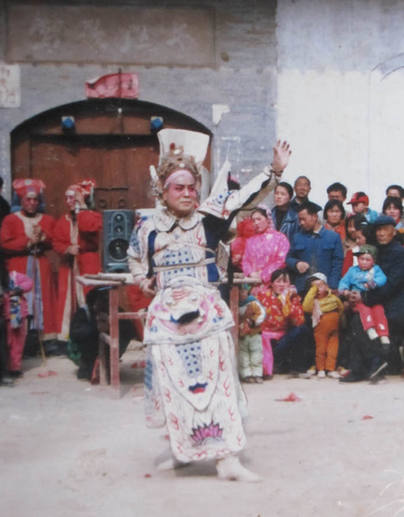Dang Zhongxin: Breathing New Life into an Antique Opera
Hop Opera, as the name suggests, is based on basic rhythms and a distinct jumping style. Every move and step the player makes resembles ancient worship rites, so the performance appears primitive but powerful. It is, therefore, classified as a type of Nuoxi Opera, a crude and wild folk art form originating in sacrificial rituals of the distant past.
The musical instruments used in Hop Opera include gongs, bass drums, cymbals and other percussion. Some plays may involve the suona trumpet, but string instruments never feature. The performance is a dance, and the actors tell rather than sing stories.
Dang recalled the traditions of Hop Opera in his village: Every year during the last month of the Chinese lunar calendar, villagers would start to rehearse the opera because by then, their farming work was done. Those rehearsals served as preparation for performances during the coming Spring Festival. Beginning from the fifth day of the new lunar year, opera actors would eagerly change into their costumes before sunrise and each team would make their way to their designated performance area. The opera, thus, lifted its curtain annually. By the 15th day of the new lunar year, a Hop carnival would be in full swing throughout the village. When the buzz died down, performers would store their costumes and instruments until the next year. For the rest of the year, they were just ordinary farmers, busy with their families and agricultural work.
“There were two unwritten rules for opera actors in our village,” explained Dang. “The first one was the inner-village rule. Every troupe performed in their communities only, performing in other villages was forbidden; the second rule was no performing during the busy agricultural season.” These rules may be the reason why fewer people are performing the opera today.
Hop Opera is only popular in the villages along the Yellow River of He-yang County, so it has distinct regional features. Compared with Qinqiang, the predominant opera in Shaanxi Province, Hop Opera is older and more primitive. Before the founding of the People’s Republic of China, residents in a dozen villages in the area knew how to perform it. However, today, only Xingjiazhuang retains this art form. Still, as Dang lamented, “Even nowadays, there are only about 20 Hop performers in my community. It’s a far cry from its heyday.”
Path of Growth
Raw talent runs deep in the Dang family. Dang Zhongxin’s grandfather and father were both Hop masters in their village. They loved the opera and were good at it, too. Traditionally, Hop actors don’t ask for payment; the local community provides their meals during the performance season and donations of costumes and props. According to Dang, his family were not rich when he was young. But despite their meager means, the family would sell their cottons and crops in order to fund the village opera troupe’s annual performances.
 |
|
Dang Zhongxin as the opera character Zhao Yun. |
- Dang Zhongxin: Breathing New Life into an Antique Opera
- Confucius: Education Should Be Accessible to Everyone – Confucius Institute Düsseldorf Builds a Bridge to Chinese Language and Culture
- Decipher the Overseas Success of “Decoded”
- If You Are the One: Love at First Sight
- Chinese Contemporary Artists (7) Wang Tiantian: A Different Story to Tell from Previous Generations
